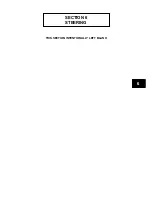
8B
HYDRAULICS
SECTION 8B. STEERING AND LIFT CIRCUIT
8B-5
SPECIFICATIONS
Pump:
Charge pump of the Sundstrand Series 15 Transmission pump. 5.4 cc/rev 18.3 litres/
min at 3400rpm engine speed.
Steering valve:
Eaton five port valve.
Steering Relief Valve: Implement valve fitted to the Sundstrand Series 15 Transmission pump.
69 bar (1000psi)
Speed restrictors:
1.27mm (0.050”) in both lines to centre unit ram, one being located in the Sequence
valve.
CIRCUIT DESCRIPTION
NOTE:
All hydraulic pump outputs and pressures are given with the engine at maximum rpm and with the oil at
working temperature.
Oil is drawn into the charge pump from the hydraulic reservoir (
Shell Tellus 46
grade or equivalent) via the 25
micron suction filter. The oil is displaced by the (5.4cc) gerotor pump at a rate of
18.3
litres/min
, at an engine
speed of
3400 rpm.
From the pump the oil flows to the “
P”
port of the Eaton steering valve. When turning the steering wheel oil is
fed from the valve to the double acting ram at the rear of the machine. Oil displaced from the other side of the ram
returns to the hydraulic reservoir via port
“T”
of the steering valve. The maximum pressure available for steering
is
1000psi.
An implement valve located in the Transmission pump controls this pressure.
If the steering wheel is not being turned then the oil flows out of steering valve from the
“PB”
port to the
“P”
port of the lift valve. If the lift levers are not being used oil flows past the spools out of the
“T”
port of the lift
valve to the oil cooler and then on to the hydraulic reservoir.
When raising units the rear of the foot pedal is pressed which energises the lift valve solenoid thus moving the
spools to feed oil out of the
“A”
port opening the check valve as it does so. The oil then goes to the front rams,
which extend and raise the units. The flow combiner/divider ensures that the front rams lift at equal speed by
controlling the rate that oil is displaced from the rams. The oil also goes to the centre ram but as the sequence
valve is closed it prevents oil within the ram from being displaced so the unit cannot lift.
After a short delay the sequence valve opens allowing the centre unit to raise. The oil flow to the centre unit ram
and from the sequence valve is restricted to slow the raise speed. Oil displaced by the rams goes though valve
port “B”
before returning to the oil cooler and reservoir.
If the Operator continues to press the foot pedal the pressure would build until the
1000psi
implement relief
blows. When the pedal is released the oil is trapped between the rams and the check valve preventing the units
from dropping.
Pressing the front of the foot pedal energises the lower solenoid on the lift valve moving the spool and allowing
oil to flow out of port
“B”.
At the same time the check valve in port “A” is lifted off its seat via a pilot line. Oil
flows to the front rams via the flow combiner/divider ensuring the units lower at the same rate. Oil also flows to
the sequence valve but this is closed initially.
After a short delay the sequence valve opens and the centre unit lowers, it’s speed controlled by the restriction
created by the orifice in the line to the valve and another fitted in the line from the ram. Oil displaced from the
rams has to pass through the open check valve in port “A” before returning to the oil cooler and reservoir.
Flotation of the units whilst cutting is not restricted in any way by the rams as they locate in slots in the unit arms
allowing full articulation.
IMPORTANT NOTE: When turning the steering wheel on a continuous full lock the implement valve will blow
and this will prevent the lift circuit from working. This is a characteristic of the circuit that should not present a
problem when the machine is used as intended.
Summary of Contents for G - PLEX WD series
Page 2: ......
Page 10: ......
Page 15: ...4 SECTION 4 DRIVE TRAIN THIS SECTION INTENTIONALLY LEFT BLANK...
Page 16: ......
Page 18: ......
Page 19: ...6 SECTION 6 STEERING THIS SECTION INTENTIONALLY LEFT BLANK...
Page 20: ......
Page 22: ......
Page 24: ......
Page 26: ......
Page 38: ......
Page 44: ......
Page 46: ......
Page 56: ......
Page 58: ......
Page 70: ......
Page 72: ......
Page 74: ......
Page 90: ......
Page 92: ......
Page 93: ......
Page 94: ......
Page 95: ......
Page 96: ......
Page 97: ......
Page 98: ......
Page 99: ......
Page 100: ......
Page 128: ......
Page 129: ...SECTION 10 ELECTRICAL SYSTEM FH Series Diesel Engine Schematic diagrams...
Page 146: ......
Page 147: ...SECTION 10 ELECTRICAL SYSTEM FJ Series Petrol Engine Schematic diagrams...
Page 162: ......
Page 163: ...11 SECTION 11 PREVENTATIVE MAINTENANCE...
Page 164: ......
Page 165: ...15 15 1 SECTION 15 NOTES...
Page 166: ...NOTES 15 2...
Page 167: ...15 NOTES 15 3...
Page 168: ...NOTES 15 4...
Page 169: ...15 NOTES 15 5...
Page 170: ...NOTES 15 6...
Page 171: ...15 NOTES 15 7...
Page 172: ...NOTES 15 8...
Page 173: ...15 NOTES 15 9...
Page 174: ...NOTES 15 10...
Page 175: ...15 NOTES 15 11...
Page 176: ...NOTES 15 12...
Page 177: ...15 NOTES 15 13...
Page 178: ...NOTES 15 14...
Page 179: ...15 NOTES 15 15...
Page 180: ...NOTES 15 16...
Page 181: ...Revision Date Author Description of Change Material Up date Sheet...
















































